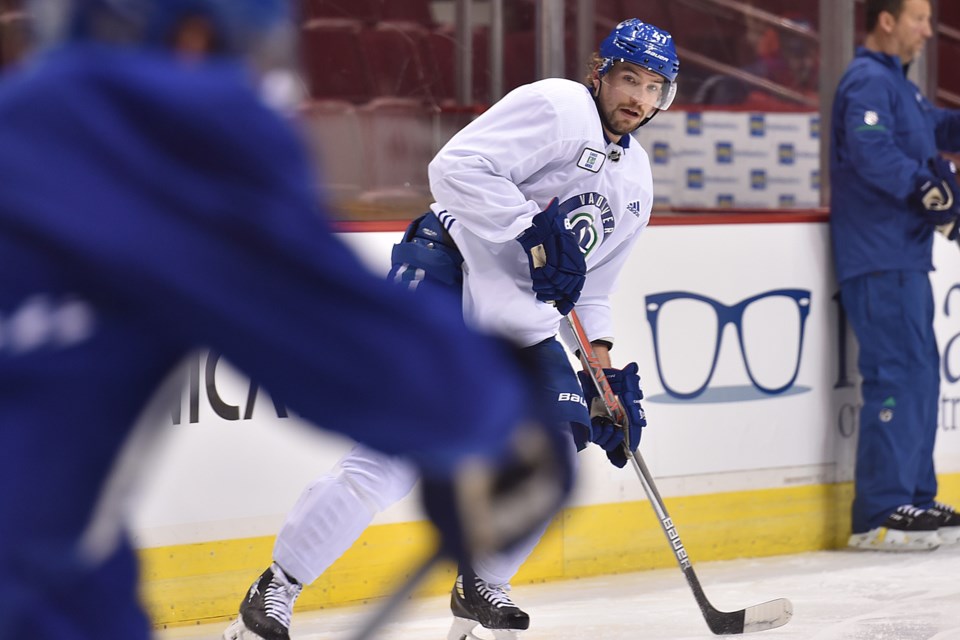The Canucks didn’t have a first line to start the season.
It certainly wasn’t the Sedin line, who were playing the equivalent of third lines minutes right from opening night. It wasn’t the shutdown line of Markus Granlund, Brandon Sutter, and Derek Dorsett, though they certainly played a lot while matched up against the opponent’s first lines. And it wasn’t the Bo Horvat line, as it was missing a key ingredient to put him and Sven Baertschi over the top.
On Saturday night, on Hockey Night in Canada against the reigning Stanley Cup Champions, the Canucks had a first line.
Horvat, Baertschi, and Brock Boeser lit up the Penguins for four goals, including Boeser’s first career hat trick. It wasn’t just the offensive output, however, it’s how they were used by head coach Travis Green.
Instead of sheltering the young line from the best the Penguins had to offer, he threw the Horvat line out head-to-head against Sidney Crosby, Phil Kessel, and Jake Guentzel. Horvat played over 20 minutes for the first time in a non-overtime game this season, while Baertschi and Boeser each played around 19 minutes.
Even though they played mostly against the Penguins’ top forward line and top defensive pairing, the Horvat line dominated puck possession; with Horvat on the ice at 5-on-5, the shot attempts were 17-10 for the Canucks. The Sedin line in limited minutes kept shot attempts even, but both of the other lines got crushed in both shot attempts and shots on goal.
It’s easy to look at the four goals and 11 points that the Horvat line put up and anoint them the official new first line of the Canucks. It would be warranted, in fact, as the Canucks have no one else able to take the reins. Before the season even started, I said that Boeser was the key to giving the Canucks a legitimate first line, and he’s proving that to be the case, elevating the games of both Horvat and Baertschi.
The difference that Boeser makes is blatant, both on the ice and in the spreadsheets. When Horvat, Baertschi, and Boeser are on the ice together at 5-on-5, their corsi (shot attempt) percentage is 52.66%; without Boeser, Horvat and Baertschi have a corsi percentage of 43.84%.
Boeser provides improvements in both corsi for and against, helping the line both offensively and defensively in terms of possession. It’s even more visible in the shots on goal: without Boeser, Horvat and Baertschi give up 44.36 shots against per hour. With Boeser, that drops down to 23.79 shots against per hour.
“I think he’s more of a 200-foot player,” says Horvat, comparing Boeser to last season. “He takes care of his own end before he jumps into the rush. His ability to get out of the zone and push the defence back… has helped us with our transition game and obviously our defensive game and it translates into good offence.”
It’s not controversial at this point to say that Boeser has been the Canucks’ best forward, which is why it still remains surprising that he wasn’t in the lineup to start the season, sitting in the press box for two games. It’s something Travis Green seems tired of talking about as it’s brought up yet again before Monday’s game against the Detroit Red Wings.
“A lot of people make a big deal out of sitting out the first two games,” says Green. “He wasn’t playing well at the end of exhibition, he regrouped, he’s learned.”
“He learns every game,” he adds.
That’s something Horvat has identified as well. “A guy like him, he works at it every day,” he says. “He’s young, but he wants to learn every day, he’s always trying to find ways to get better. It doesn’t surprise me he’s gotten off to such a great start.”
Horvat’s game has evolved as well. He’s been criticized for not using his wingers enough, but now he describes himself differently. “Sven and I, we look to dish more than we like to shoot,” he says, which would have been laughable before his three assists on Boeser’s hat trick. The passes he made were those of a great playmaking centre, rather than a north-south, net-crashing, two-way centre.
As for Baertschi, he brings the softest hands — and feet — on the team. On Boeser’s second goal, Baertschi took Horvat’s centring pass off his skate, kicking it up to his stick to tip it to Boeser at the backdoor.
“Not a lot of guys [can] pick it up from their skate and tap it to him backdoor, all in a split second,” says Horvat. “It takes skill and a special player to make those kinds of plays.”
But when Green is asked about their line, he doesn’t talk about Horvat’s playmaking, Baertschi’s skill, or Boeser’s finish. He looks to the defensive zone.
“You look at a lot of their goals, how they scored, there might have been a good play in the offensive zone, but there were other things that led up to the goal,” he says. “Those are little things that go unnoticed.”
Those little things, rather than necessarily the offence, are what will keep that line as a first line. The line won’t combine for eleven points every single night, but if they can match-up against the best the opposition has to offer and do all the little things right in the defensive zone, Green will keep giving them first-line minutes.



